
L'avenir de la restauration ?
« Autrefois considérée comme une nouveauté high-tech, la technologie à induction redéfinit aujourd'hui les cuisines professionnelles à travers le monde »
Alors que le secteur de l’hôtellerie-restauration est confronté à la hausse des coûts de l’énergie, à des objectifs de durabilité et à une demande croissante d’efficacité, la cuisson par induction commerciale s’impose comme une solution transformatrice. Autrefois considérée comme une nouveauté high-tech, la technologie à induction redéfinit aujourd’hui les cuisines professionnelles à travers le monde.
Qu’est-ce que la cuisson par induction ?
Contrairement aux plaques de cuisson à gaz ou électriques traditionnelles, la cuisson par induction utilise des champs électromagnétiques pour chauffer directement les ustensiles de cuisine. Ce procédé permet un transfert de chaleur quasi instantané, l’énergie allant directement dans la casserole plutôt que de se perdre dans l’environnement ambiant. Résultat : un contrôle précis de la température, des temps de cuisson plus courts et une réduction significative du gaspillage énergétique.
Efficacité et durabilité
Les plaques à induction offrent un rendement énergétique pouvant atteindre 90 %, contre environ 40 % pour le gaz. Elles représentent donc un choix convaincant pour les cuisines professionnelles cherchant à réduire à la fois leurs émissions de carbone et leurs factures d’énergie. Avec le durcissement des réglementations gouvernementales et des objectifs de neutralité carbone, de nombreux traiteurs se tournent vers l’induction comme étape proactive vers des opérations plus écologiques.
Amélioration des conditions de travail
Les cuisines professionnelles, souvent très chaudes, sont réputées pour leurs conditions de travail inconfortables. La cuisson par induction dégage moins de chaleur ambiante, ce qui réduit non seulement les coûts de climatisation, mais améliore également le confort et la productivité du personnel. Les cuisines deviennent aussi plus calmes, puisqu’il n’y a pas d’allumage au gaz ni de flamme nue. Un petit changement, mais avec un impact significatif au quotidien.
Avantages en matière de santé et de sécurité
Les atouts de l’induction en matière de sécurité sont indéniables. Sans flammes nues ni surfaces chauffées à blanc, le risque de brûlures et d’incendies est fortement réduit. Les surfaces refroidissent rapidement après usage. Des fonctions d’arrêt automatique ajoutent une couche supplémentaire de sécurité, particulièrement précieuse dans les environnements à fort roulement où la sécurité du personnel est primordiale.
Flexibilité et innovation
Les appareils à induction modernes offrent des fonctionnalités intelligentes telles que des réglages programmables, le chauffage multi-zones ainsi que la connectivité Bluetooth ou Wi-Fi pour un suivi et un diagnostic à distance. Ce niveau de contrôle peut optimiser les opérations dans les entreprises de restauration multi-sites, les hôtels et les cuisines à haut volume de production.
Perspectives
Si l’investissement initial peut être plus élevé, les économies à long terme et les gains opérationnels convainquent de plus en plus d’entreprises de franchir le pas. À mesure que les réseaux électriques se décarbonent et que la demande pour des cuisines plus propres augmente, la cuisson par induction est bien placée pour devenir la norme dans le secteur.
Conclusion
Pour les chefs et traiteurs visionnaires, passer à l’induction n’est pas seulement une amélioration : c’est une étape essentielle vers l’avenir de la restauration.
Article préparé par un chroniqueur des Actualités en ligne de la Chaîne, sauf erreur ou omission.